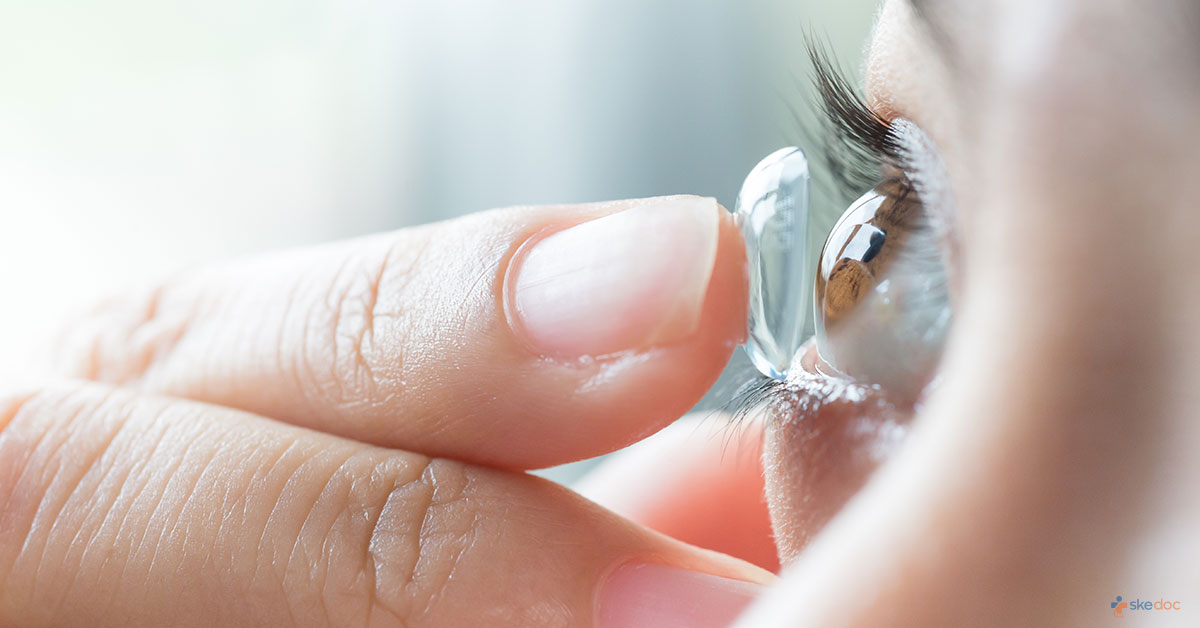Allergy
Blood Diseases
Bone & Joints
Brain
Cancer
Child Care
Cosmetic Surgery
Diabetes
Endocrinology
ENT
Eye
Gen Medicine
General Surgery
Heart
Kidney
Lifestyle
Liver & Digestive
Lung
Men’s Health
Mental health
Physiotherapy
Rheumatology
Skin and hair
Sleep Disorders
Spine
Transplant
Women Health
Thyroid
Vascular Surgery
Contact Lenses

What are Contact Lenses?
Contact Lenses, also known as Contacts, are thin clear disc-shaped lenses that are placed directly on the surface of the cornea and float on the tear film. A lot of individuals prefer contact lenses over eyeglasses for reasons such as better aesthetics, and comfort, while certain medical conditions are better corrected with lenses than with eyeglasses.
Types
- Hard or rigid gas permeable lenses (RGP)
- Soft contact lenses
- Daily wear - disposable lenses that are used only once
- Extended wear - Can be used for an extended period, require regular cleaning
- Toric lenses
- Coloured or decorative contact lense
- Presbyopia contact lenses
- Multifocal
- Monovision
- Chromagen lenses - For color and night vision correction
- Scleral - These are therapeutic lenses that are used for the management of certain medical conditions
- Bandage lenses
Indications
Some of the indications for contact lenses include the following:
- Correction of refractive errors:
- Myopia
- Hypermetropia
- Astigmatism
- Presbyopia
- Colour vision defects
- Night vision defects
- Cosmetic
- Therapeutic
- Therapeutic scleral lenses:
- Keratoconjunctivitis sicca (dry eye syndrome)
- Microphthalmia
- Keratoconus
- Corneal ectasia
- Steven johnson’s syndrome
- Aniridia
- Sjogren’s syndrome
- Post LASIK complications
- Post corneal transplant complications
- Chemical burns and trauma to the cornea
- Therapeutic soft lenses:
- Bullous keratopathy
- Corneal abrasions and erosions
- Keratitis
- Corneal edema
- Descemetocele
- Mooren’s ulcer
- Therapeutic scleral lenses:
Risk factors
- History or presence of regular eye infections
- History or presence of severe allergies
- Dry eyes
- Residing or working in dusty environments
- Individuals who are incapable or unable to maintain or take proper care of the lenses
Investigations before the procedure
A proper and thorough medical history and ophthalmic examination are all that is needed before using the lenses.
Description of the procedure
The process of wearing contact lenses is very simple, but the following steps provide a proper and safe way to use them are:
- Washing and rinsing hands thoroughly before handling the contact lenses
- The fingertips should be used to handle the lenses and remove them from the case. Nails should not be used to handle contact lenses.
- Rinsing the contact lens with a contact lens solution. Tap water should not be used to clean the lenses.
- The contact lens should be placed on the tip of the index or middle finger of the dominant hand (writing hand)
- Before putting the lens into the eye, it should be checked to see if there are any tears or damages to the lens surface
- The lens should form a bowl with the edges turned “up” and not a lid with the edges turned out
- The upper eyelid is held back with the non-dominant hand and the lower eyelid is held down with the middle of the ring finger of the dominant hand while looking into the mirror. Alternatively, both the upper and lower eyelids may be held and pulled back with the non-dominant hand.
- The lens is then placed in the eye while looking up or straight ahead
- After the lens is placed on the eye, the eyelids are closed, and the eyes are rotated a full circle slowly to help settle the lens properly in the center of the eye
- The eyes should be opened and blinked a few times and then ensuring that the lens is sitting perfectly
- The process is repeated for the other eye
Role of diet/ Exercise/ Lifestyle changes/ Preventive measures
Some measures that are useful when using contact lenses include:
- Hand hygiene and cleanliness before handling contact lenses
- Keeping nails trimmed and tidy and avoiding using nails to handle lenses
- Avoiding the use of damaged or torn lenses
- Cleaning and maintaining as advised
- Removing contact lenses before taking a shower, swimming, or any activity where there is a chance of water getting into the eye
- Never use saliva to wet or clean the lenses
- Never use a saline solution to clean lenses
- The cleaning solution bottle should be stored with the lid properly closed
- Always use a fresh cleaning solution and never mix old contact lens cleaning solution in the case by topping it up with a new cleaning solution
- Never store or transfer contact lens cleaning solution to a different bottle than the one it came packaged in
- Clean the case regularly with contact lens cleaning solution and not tap water
- Replace and change cases at least every 3 months
- Do not use contact lenses that have been stored (including in a sterile solution) in a case for more than 20 to 30 days
Complications
- Ptosis - Drooping of the eyelid
- Conjunctivitis
- Corneal abrasion
- Corneal erosion
- Keratitis
- Corneal ulcers
- Corneal neovascularization - The growth of blood vessels in the cornea
- Corneal edema
- Corneal infiltrates
Prognosis
Contact lenses are safe and effective when used with proper care and under medical advice. Improper use of lenses can sometimes lead to very serious complications.
Suggested clinical specialist/ Departments to consult for the procedure
These are prescribed by specialists from the Departments of Ophthalmology and Optometry.
Was this article helpful?
YesNo




